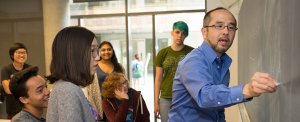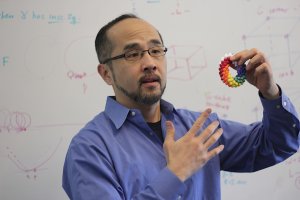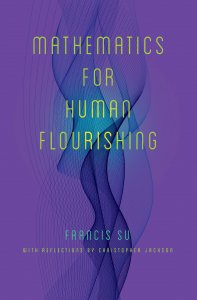How did you get into math?
I got interested in math at a young age. I was captivated by the way that mathematical reasoning could take advantage of patterns to answer seemingly hard questions. For instance, I remember being asked the question: what is the sum of all the numbers from 1 to 100? That seems like a hard question. But then someone showed me that if you pair 1 with 100, 2 with 99, 3 with 98, etc., then you see 50 pairs of numbers where each pair sums to 101. So it’s suddenly clear that the total is 50×101, which is 5050. That is the part of mathematics that excites mathematicians—the discovery of patterns and trying to understand those patterns. Over time, as I learned more mathematics, I began to see how it enables you to tackle big questions like, “What is the nature of the infinite?”—a mind-blowing question. You are compelled to ask philosophical questions like: Does math actually model the world? Is it a good model? Or is it just a convenient figment of our imaginations?
Many people find math intimidating or think, “I’m never going to need this.” How do you respond to that?
Part of the problem is that we’ve sold math as a bunch of skills you need in order to get a good job or a good career or to be credentialed, and that’s a very utilitarian view. It’s also probably not true that you need specific skills, like factoring an algebraic expression, for most jobs or careers. And that view completely overlooks what’s captivating about math—the beauty and the wonder of thinking, of using your mind in creative ways to find unexpected and enchanting ideas. And this virtue of being a creative thinker is something that people definitely will need in lives and careers.
Unfortunately, the very utilitarian view of math has infected the way we think about it and talk about it. People say, “Just do the math,” when what they’re really saying is “Just do that calculation.” I like to say that anything a calculator can do isn’t math. The reason that we as humans do math is to try to understand. We want to understand patterns, we want to understand why the calculator is spitting out whatever answer it’s spitting out. We shouldn’t just be satisfied with recipes for how to do things—we should all demand that math make sense. The shift that has to take place is for people to see that intrinsically math is worth doing because it’s really about cultivating your mental abilities, and it’s really about enjoying that experience. I would love it if we could teach math with an attitude of wonder and discovery the same way you might teach astronomy or biology. I would love it if people would begin to see math as something you explore and enjoy.
How does taking an approach of wonder and discovery change how people learn math?
One thing that’s an immediate change is an attitude that asking questions is more important and interesting than simply getting answers. Asking, “Where does that pattern come from?” is much more fulfilling than, “Can I do these calculations quickly?” That’s another thing that is really detrimental to the way we teach math; we think about math as something you have to do quickly. A lot of kids unfortunately have very bad experiences because they were forced to do things quickly and they think math is about speed when it’s really not about speed at all.

Francis Su teaching a class. (Credit: Harvey Mudd College)
One of my students said she got interested in math because her dad asked her lots of interesting questions like, “How long would it take to reach that wall if at every step you went halfway?” And so rather than dad telling his kid the answer, he asked her so she could think about it. So, she’s grappling with a very interesting notion, the idea of infinity. And the realization of, “If you walk to a wall, and you step halfway each time, you’ll never reach it”—she came to that herself. And that’s part of the wonder that was cultivated in her by her dad by asking questions, rather than saying “Hey, infinity’s this concept,” and explaining it. She’s just a kid, and see how he’s already introducing beautiful and interesting ideas by asking questions.
Part of what makes math interesting is that you’re confronting some really interesting ideas, almost philosophical or spiritual ideas like, “What does it mean to be infinite?” and, “What does forever mean?” These are basic human questions that you confront if you try to expose people to math in the right way. Minds open, and you grapple with beautiful, interesting questions. Even at a very young age, you can do that.
If you want to teach somebody their times tables, forcing them to memorize it is probably very boring, and most kids don’t enjoy it. But asking them to look for patterns is interesting. And not only that, but it also makes it easier. That’s the way I learned the times table—I started searching for patterns. “Oh, look, there’s a bunch of 5’s in this column, because if you multiply anything by 5, you get something that ends in 5 or a 0.” When you look for patterns, things become a lot more interesting and natural to do.
For a parent, you can teach math by bringing out the math in the everyday. Say you have your kid join you to bake cookies; you have to combine fractions. As you’re doing something fun, by asking them to think about what they’re doing, “Is one part of three bigger or smaller than one part of four?” you can get your kid grappling with these basic but interesting questions, and getting them to think for themselves.
And part of good teaching is helping people come to their own realizations without being scornful of wrong answers. Helping your kid learn math in an environment without shame, and especially not shaming them for being slow, can be really helpful in teaching your kid math in a more humane way. We don’t make fun of kids who hit a wrong note when they’re learning the piano, right?
Part of what makes math interesting is that you’re confronting some really interesting ideas, almost philosophical or spiritual ideas like, “What does it mean to be infinite?” and, “What does forever mean?” These are basic human questions that you confront if you try to expose people to math in the right way.
How do you create more inclusive environments for learning math or other STEM subjects?
The heart of inclusive teaching is thinking about what you’re doing and how it will be received by different audiences. That involves putting yourself in the shoes of different learners, which is hard to do if you don’t have a wide variety of experiences yourself. A first key ingredient of inclusive teaching is understanding your students’ stories and hearing their experiences. The only way you connect to anybody is understanding their experiences. What do they care about? What are the desires that motivate them?
Good teaching is really good listening. Think about how to connect what you’re teaching to the things that matter to students. And that actually requires a lot of work by the teacher to understand stories and experiences, especially if students have a different cultural background or a different religious background. That’s part of what happens often with people with color in STEM—they’re not approached by teachers with cultural humility, the attitude is more like, “Here’s what we have to offer you,” instead of thinking about what teachers can learn from the students, and how they can build on the thinking students are already doing and the experiences they already have.
Good teaching is really good listening. Think about how to connect what you’re teaching to the things that matter to students…. [think] about what teachers can learn from the students, and how they can build on the thinking students are already doing and the experiences they already have.
I’ve been in environments, both as a teacher and student, where professors will casually make disparaging remarks about, for instance, people of faith (like: “How can anyone believe such stuff?”). Rather than doing that, a better approach would be to harness people’s experiences in positive ways; for instance, some of the deep questions that we ask are deep spiritual questions that are worth exploring. What does it mean to be a human being? Where does human dignity come from?

Francis Su showing a model of a torus.
One deep question that comes up around math is, “Is math created or discovered?” I personally think it’s both, and my own faith inclinations also lead me to think that. You can be a co-creator of something. I can have the same thoughts as Newton did 400 years ago, mathematically speaking. That’s amazing, when you say to yourself: “What? I can actually have the same mathematical thoughts as somebody else and come to the same conclusions? Why is that? What reality are we both accessing?” When you tap into those kinds of questions, it opens up a lot of possibilities in the classroom. These are basic longings that all of us have to address deep questions. And there’s opportunity to do that for every subject. The critical piece is humility: listening to and honoring students so you can connect with them. Somebody who’s teaching inclusively would actually harness the experiences of their students rather than disparage them.
And on a wider scale, an attitude of humility is also relevant whether you’re trying to address misunderstanding in the classroom or misinformation on social media; how do you honor the other person and create an atmosphere where you can gently correct?
The critical piece is humility: listening to and honoring students so you can connect with them.
You talk in your book about human flourishing and math; how do those intersect?
What does it mean to flourish? It’s not just having a comfortable life; you can flourish even in difficult circumstances. A central example in my book is the story of a friend of mine who is incarcerated and who discovered math in prison. And part of what you hear in his story are some of the challenges of learning in an environment like prison, and yet I think if you look at his story, you see that he is flourishing in these very difficult circumstances.
I think of human flourishing as having an aspect of both being and doing. Not only do you see yourself as being in a place where you are flourishing, but you have an obligation to help others flourish as well; it’s individual and it’s collective. In the Jewish tradition, there is this idea of shalom, which is translated as peace, but it has a richer connotation; people live and experience shalom when things are in right relationship to one another. In the book, I try to help people see that mathematics, in its best forms, ought to be about human flourishing. And that’s a very different notion than the idea that math is an elite credential, intended to show how much better I am than you. Rather, if you believe that math exists to help people flourish, then you see that math is actually something that all of us should have the opportunity to experience, and even demand. It’s something that we miss out on if we don’t experience that part of life.
How is math relevant to thinking about what it means to be human?

The cover of Francis Su’s book, Mathematics for Human Flourishing. (Credit: Yale University Press)
Part of the way math is connected to flourishing is for people to see how math connects to some of the deepest longings they have. We all have a longing for beauty, and math meets that longing in a unique way. I would hope that everybody has an opportunity to visit an art gallery and see art from many different cultures. In the same way, I hope everybody has an opportunity to do some delightful mathematical thinking and experience that.
I think we all have a desire for truth, too. I think math lends itself to accessing truth and helping us understand truth better. When you see a mathematical truth, you have a certain confidence in it that’s different than the confidence you might have in other kinds of truth. A historical truth, for instance, can be hard to verify. But we have lots of confidence in mathematical truths because they are so self-consistent and there are often so many ways to verify truths. If I have multiple ways of understanding truth, then I actually have greater confidence in that truth. I’ll also know when I’ve made an error. If I punch into my calculator 10 times 10 and it says the answer is a million, I know something’s wrong with that because I know something about the size of a number that is 10 tens. I have a different way of accessing that truth than just punching it into a calculator. In some ways, we do that with other truths too—we can’t directly verify historical truths or claims that people make to us, so we ask, “Is that reasonable? Are there multiple ways of understanding it?” I think the most important thing a teacher can do is not just teach a calculation, but also ask the question, “Is that reasonable?”
And all of us have a desire for freedom, and math helps us access a certain kind of freedom, to figure out truths for ourselves. We have a desire for community, and if math is taught properly, it should tap into that desire in the way we do math together.
Math also builds virtues when it addresses those deep desires. We all have a desire to explore; exploration cultivates virtues in us, like the virtue of creativity. Math enables in us the virtues of clear thinking and thinking for oneself, which ideally should carry over to other areas of our lives. And math should build in us an expectation of enchantment—that’s a virtue built by going on an exploratory adventure. There ought to be the expectation of enchantment every time I go into a math class. The best math classes I took in college are ones where I was enchanted every time I went to a lecture; something happened in that lecture that helped me see something amazing, and every math class should be like that. And if it’s not, maybe we can change that.
If I have multiple ways of understanding truth, then I actually have greater confidence in that truth.
What advice would you give to people trying to do public engagement around mathematics?
I think good public engagement around math should entice people to see what’s enchanting about mathematics, and it should challenge the idea that math is only for some. The way I think is most effective is to help people see how math connects to the deep human desires that people have. Good public communicators will honor those desires in thinking about how to communicate math or science. That’s one of the biggest things I’ve learned during my time teaching. The heart of inclusive teaching is connecting with people. It’s too easy for scientists to say, “No, my job is to teach science. My job is to teach just the facts,” but I think that’s missing a very, very important component, which is people. How do you reach and speak to people? Well, that involves more than just exposing people to science. It means honoring people, engaging their deep human longings, and understanding how math and science intersects with their lived experiences. Good public engagement should demonstrate a deep care for your audience, not just care for the material you present.
It’s too easy for scientists to say, “No, my job is to teach science. My job is to teach just the facts,” but I think that’s missing a very, very important component, which is people.





